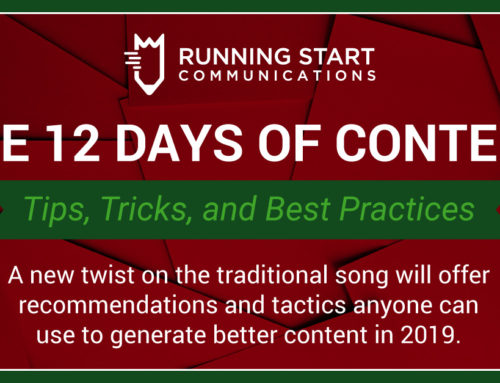A closer look at what’s wrong with content marketing–and how to make it right.
WWelcome to the very first blog article from Running Start Communications. This blog will offer every-so-often observations on the current (often sad) state of business writing today, and hopefully, provide some tips and best practices to help us all improve.
Not that I’m an expert, but to borrow a line from Farmer’s Insurance, I know a thing or two because I’ve seen a thing or two, and I’d like to share them with you. I hope that this information is helpful and that you’ll check back now and again. As always, let me know what you think.
Producing crappy content is not a content marketing strategy
For this first article, I wanted to talk about content, and more specifically, content marketing. “Content” is a word that’s thrown around a lot these days, usually as a shorthand reference to content marketing, which is a much larger, specialized marketing approach. Yet the two are not always the same.
Companies don’t see the distinction face real risks. At best, poor content strategies will simply fail to connect with the audience, making it more difficult to convert or sell. At worst, overwhelming customers and prospects with too much bad content will alienate them, possibly to the point where they leave forever. In this case, content can actually prevent a company from achieving a specific goal and can even damage the brand’s overall reputation.
How did we get here?
Clearly, marketing content is very important. Traditional marketing tools like brochures, datasheets, case studies, and more communicate the benefits of a particular product or service. And in today’s digital marketing world, SEO-friendly content is vital to improve page rankings, generate leads, and drive traffic to a company’s website.
All of this is great. Yet the pressure to meet aggressive lead and growth goals has marketing teams scrambling to create content faster than ever. Unfortunately, this is not always a good thing. Content planning and strategies are now virtually non-existent, and the overall quality of writing has taken a turn for the worse. (More on these topics in future blogs.)
Here’s a perfect example: I recently sat in on a meeting where a digital marketer told a content producer that it really didn’t matter what she wrote, but they needed to publish one or two blogs per week. This is a far cry from using content strategically and making sure it’s consistent with corporate positioning and branding. (Fortunately, this company did not go with this approach.)
We’re fooling ourselves
So many marketing teams think that blasting low-quality, irrelevant, and salesy content is an effective content marketing strategy. After all, they’re producing a lot of content on a regular basis, and what could be wrong with that?
Yet in doing so, so many overlook the very tenet of content marketing. According to the Content Marketing Institute, “Content marketing is a marketing technique of creating and distributing valuable, relevant and consistent content to attract and acquire a clearly defined audience – with the objective of driving profitable customer action.”
I’d like to emphasize a few key words here: “valuable,” “relevant,” and “clearly defined audience.”
These terms suggest that, to truly use content marketing as an effective strategy, marketers need to understand their audience, develop a concrete plan, and do all they can to deliver high-quality, relevant, helpful information.
So many marketers go wrong because they simply don’t have time to create long-term strategies and the content their audience actually wants to receive. In their rush to influence SEO results and publish a blog today, they quickly throw together a post that uses warmed-over product information that doesn’t really communicate anything new or beneficial to their audience.
Sure, they met a deadline and may have even moved the SEO needle a little. But the vast majority of these types of content simply aren’t intended to help customers and prospects, and as a result, fail to deliver on the potential content marketing represents.
In my opinion, much of today’s content simply is not content marketing. Future blog articles will highlight ways companies can improve their content marketing efforts–and results–as well as real-world examples of content done right. I hope you’ll check back for more updates.



Leave A Comment